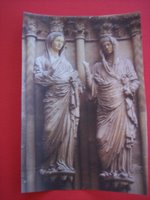Art Imitating Life?


In the long History of Art, one of the pinnacles of human expression is found in the exquisite statuary standing in the portals of Gothic Cathedrals. Two exemplary groupings that still exist can be found in the jamb of the central doorway of the Royal Portal at Chartres Cathedral in Chartres, France. They are representations of Old Testament Kings and Queens. They were sculpted between 1145 and 1155 A.D. The other grouping of jamb statues is in the central doorway of the west facade portal at Reims Cathedral in Reims, France. They were wrought almost 100 years later in 1230 A.D. It is called "The Visitation" because it celebrates the "Annunciation" by St. Elizabeth and Mary, mother and daughter. It is part of a series of statues illustrating the Life of the Virgin Mary in that Portal. (see above photos)
Both groupings represent ancestors of Christ. The Kings and Queens may be distant, Biblical relatives, while Elizabeth and Mary were quite close, mother and grandmother. The Kings and Queens were dressed in 12th Century garment and could also be thought of as present-day royalty (hence the name, Royal Portal). It was this modern identification that put them in jeopardy during the French Revolution when statues of secular Kings and Queen were being vandalized ie. Saint-Denis Cathedral. They were easily accessible being almost at eye-level in the jambs or sides of the doorways. This was thought to be done to show the kindly faces of these figures and not the mask-like visages of the Romanesque Style portraits. Mary and Elizabeth were more approachable and meant to inspire love. Mary became central to Gothic Iconography.
The Kings and Queens were actually statue-columns and, from a distance, looked like vertical decorative accents holding up the lintels under the massive tympanums of statuary. They were rigid, upright and elongated with elbows close to their sides under the very linear folds of their robes. However, unlike the classically styled Caryatids of the Erechtheion on the Acropolis in Rome, these Old Testament Patriarchs did not literally support the New Testament Saints above; only by appearance, figuratively. They stood out three-dimensionally but not as much as the Visitation Grouping. Mary and Elizabeth appear to be completely detached from their background. Their columns are shrunken and don't restrict their free and easy allusion to movement. They are portraits of specific individuals in the fully-ripened High Gothic Style. These classicized figures hadn't been seen since Roman times and they even were posed in the Greek contra postal posture with one foot forward and a right bent knee under their loosened garments. Swaying, child-bearing hips can even be imagined. It is thought that the master sculptor might have borrowed actual Roman sculpted heads for patterns ie. Younger Mary could easily be Faustina, the Younger, Marcus Aurelius' wife. These were the first signs of a New Naturalism in Gothic Style and progress can be seen over this 100 years from characterizations of Kings and Queens to the actual individuals of Elizabeth and Mary having a conversation in a Biblical narrative. Their faces are turned towards each other and there remains some evidence of paint.
The Catholic Church commissioned these works of Art and placed them at the entrances to their cathedrals for definite reasons of worship and proselytizing converts. They believed they were "imitating" the True Life of the Saints, Kings and Queens. Their belief in Mary and the Virgin Birth became so strong that much of the Art, statues, paintings, icons and relics took on "lives" of their own becoming the objects of worship and devotion. "Life" might have begun to "imitate Art"; especially in the hearts and imaginations of the True Believers. Yes, in the long History of Religious Arts, it is quite easy to see how this might happen even today, in the Modern Era; with the popular fascination for the "DaVinci Code" novel about another Mary. Bob!

1 Comments:
My other choices for comparison and contrast for this final essay were interesting but not as engaging from an artistic point of view for me. The two columns with the scrolled relief of historic battles ie. Trajan's and Bishop Bernward's (life of Christ) are monumnetal. I've walked around Trajan's Column near the Pantheon in Rome. The other two architectural works of art in Italy ie. The Temple of Fortuna Virilus near the Forum and Orvieto Cathedral are very eclectic in composition but not as involving emotional now days. I've seen the Temple near the Circus Maximus and it is very small. Bob!
Post a Comment
<< Home